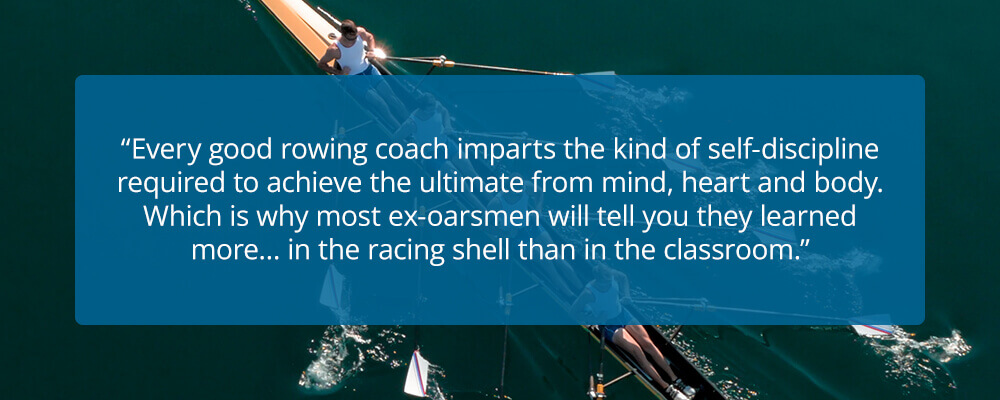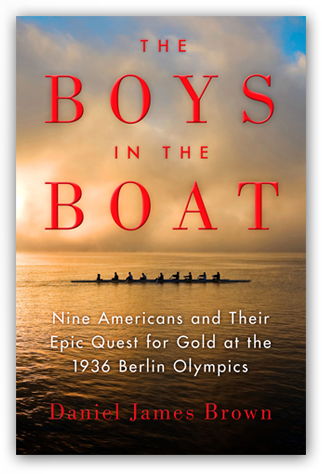Rowing is recognized as the quintessential team sport. How do I know? From seeing motivational posters with rowing photos and headlines like “TEAMWORK!” in offices nationwide to inspiring employees to “pull together” to achieve operational and management excellence, and successful strategy execution! (Oh, and also I rowed four years in college.) But it’s the poster thing that, as a rower, I always found funny since most people in America know very little about rowing, or “crew.” Yet still, somehow rowing became the universal symbol of working hard to achieve a collaborative goal. This is sort of like people across America adopting images of competitive baking to symbolize grace under pressure.
Whether you fall into the category of people who buy such posters, or cynics like me who scoff at them, you can learn a great deal about goal setting, management excellence, and achieving greatness from Daniel James Brown’s best-selling book, The Boys In the Boat, which tells the amazing story of a group of depression era outsiders – the national champion University of Washington men’s crew – who went on to win gold for the United States at the 1936 Berlin Olympics.
I’ve read a number of good pieces about The Boys that draw management, strategy execution, and leadership lessons from what these remarkable young men achieved. But none was written by anyone that rowed themselves. And none focused less on The Boys themselves, and more on the Yoda-like spiritual guru of the story, legendary racing shell builder George Pocock, whose workshop was in the attic of the UW Conibear Shellhouse.
Boys is chock full of inspirational quotes by Pocock that put rowing into perspective in a way I’ve never heard. This first may pain some folks when they think about the cost of four years of college, but it’s the truth and I’m happy to hear someone else feels the same way I do:
“Every good rowing coach imparts the kind of self-discipline required to achieve the ultimate from mind, heart, and body. Which is why most ex-oarsmen will tell you they learned more… in the racing shell than in the classroom.”

So, as a tribute to The Boys, their coaches, and Pocock (the name emblazoned on the wooden eight I first rowed in as a freshman at Ithaca College), here is a summary of lessons in strategy execution and business leadership to help lead any kind of team to collaborative greatness.
Pocock: “In a sport like this – hard work, not much glory… well, there must be some beauty which ordinary men can’t see, but extraordinary men do.”
Lesson 1: A great team must share a vision. As a leader, it is your responsibility to impart this to your team. To inspire them to want to bring this vision to come to fruition regardless of the challenges ahead. When you can create that kind of shared, aligned sense of vision among a team of like-minded and talented people, greatness follows.
Pocock: “It is hard to make that boat go as fast as you want to. The enemy is the resistance of the water… But that very water is what supports you and that very enemy is your friend. So is life: the very problems you must overcome also support and make you strong in overcoming them.”
Lesson 2: Overcoming adversity makes the team stronger. Fans of HBO’s Silicon Valley might liken this to Gavin Belson, CEO of Google look-alike Hooli, trying to convince the board that “failure = success.” But we also all know this to be true. No great success happens without rising to overcome challenges. Each time a team does this, they get better and better. Especially when you set out to accomplish big things at the start.
Pocock: “Rowing a race is an art… rowed with head power as well as hand power… all thoughts of the other crew must be blocked out. Your thoughts must be directed to you and your own boat.”

Lesson 3: Excellence comes from focus. Anyone who has ever rowed will back this up. When you take time to glance at the crew next to you to see if you are beating them, you lose. It throws off the balance of the boat. The Boys had an acronym they’d repeat to themselves: MIB, “Mind In Boat.” It holds true in business too. Keep your eyes on what you’re doing. And an eye on where your customer is going. When you think too much about your rivals, you risk second-guessing your own path to greatness.
Pocock: “Rowing is perhaps the toughest of sports. Once the race starts, there are no time-outs, and no substitutions. It calls upon the limits of human endurance. The coach must therefore impart the secrets of the special kind of endurance that comes from mind, heart, and body.”
Lesson 4: Don’t micromanage. Provide guidance, inspiration, and leadership at the start and whenever necessary. But give people responsibility while the race is in progress. Let them push themselves to their own limits. This will bring out the best in them. Just like in business: give your employees visibility and alignment to the strategic plan and empower them for excellence in strategy execution.
FREE RESOURCE
Leading from the Center
Download this guide to understand how to optimize power and influence to accomplish your most important initiatives.

Pocock: “A boat is a sensitive thing, an eight-oared shell, and if it isn’t let go free, it doesn’t work for you.”
Lesson 5: Empower your team with the courage to change strategy. The Boys learn this firsthand. On their way to the Olympics, they need to win a few major US collegiate races first. In one decisive race, coxswain Bobby Moch hangs behind rival Cal for the bulk of the race, waiting to strike as they close in on the finish. Coach Al Ulbrickson didn’t tell him to do this, it was definitely not part of the race plan, but Moch read the situation as it unfolded and changed strategy on the fly. The result; stellar strategy execution and a huge win that led to Washington’s Olympic berth.
Archival video of 1936 US Olympic win. Note, eights start at 1:09 mark, at 2:44 the US boat first appears, and at 3:22 they win.
Pocock: “One of the first admonitions of a good rowing coach… is ‘pull your own weight,’ and the young oarsman does just that when he finds out that the boat goes better when he does.”
Lesson 6: Hold people accountable. Once you set your plan in motion, hold people responsible. Accountability is highly correlated with strong strategy execution. Reward them if they deliver. If they can’t, replace them with someone who can. The Boys introduce us to ‘seat races’ where two boats race, stopping to trade rowers to see who makes the boat go faster. When you find out, they win the seat. That’s how high-performance teams are created.
FREE RESOURCE
4 Stages to Create a Culture of Execution
Download this guide to learn how to build an organizational culture that amplifies execution and results.

Pocock: “When you get the rhythm in an eight, it’s pure pleasure to be in it. It’s not hard work when the rhythm comes – that ‘swing’ as they call it. I’ve heard men shriek… when that swing comes in an eight; it’s a thing they’ll never forget as long as they live.”
Lesson 7: Plan, execute, monitor, repeat. A team that plans well, and executes well against plan, becomes a well-oiled machine destined to achieve objectives and win repeatedly. When you build and empower a team to do this, there is no limit to what they can achieve working together.
Pocock: “To be of championship caliber, a crew must have total confidence in each other… confident that no man will get the full weight of the pull…”
Lesson 8: Goals must be aligned across the entire team. This is true in many team sports. Anyone who can’t see or support the shared vision or goal can bring the entire team down with them. But when there is true transparency, and when they realize that all the other members of the team are aligned and counting on one another, it brings out the best in each member of the team. This holds true in business: if employees can’t see or support the strategic plan, strategy execution is bound to fail.
Pocock: “My ambition has always been to be the greatest shell builder in the world…I believe I have attained that goal. If I were to sell the stock, I feared I would lose my incentive and become a wealthy man, but a second-rate artisan. I prefer to remain a first-class artisan.”
Lesson 9: Goals must transcend the attainment of wealth. It is fine to want to get rich. But the path to riches is faster when people have a larger goal in mind. When you wish to be the best at something first, wealth follows. The reverse of this story is not often so certain.
Finally, Lesson 10, not one from Pocock, but rather, from me.

Lesson 10: Let it run. Along with the “swing” Boys talks about, there is another great Zen-like experience in rowing called the run. It occurs when a crew rowing at full speed stops rowing suddenly holds their oars just above water level and lets the boat glide. A great crew will find their boat runs like it’s flying. I’m lucky enough to have rowed in a boat that did this a good bit. The experience translates well to business. When a leader empowers their team to be their best and then steps out of the way to let them do it, great things happen as a result.
There are of course lessons to learn about strategy execution, teamwork, and leadership excellence from all sports. But not many that inspire the kind of fanaticism that crew does. For most people who participate in a crew, their playing days end after college. I haven’t sat in a crew shell in, well… a long time. But it is ingrained in my psyche to this day. I try to bring it to work with me every day. And now, thanks to the story of The Boys In The Boat, and the inspirational words of George Pocock, you can, too.
About AchieveIt
AchieveIt is the platform that large organizations use to get their biggest, most important initiatives out of the boardroom and into reality. Too many great ideas never quite make it across the finish line, because there’s no real way to keep everyone on course and keep everything on track. What does it take to actually guide these initiatives all the way through to completion? You’ve got to:
- Get everything in view – so you can see what’s happening with every initiative, at every level, from the enterprise to the individual, in real time.
- Get everyone engaged – with an easy-to-use platform that connects your organization from the executive leadership to the project teams, keeping everyone accountable and on the same page.
- Get every possible advantage – not only because you have the premier platform in this space, but because you can draw on the experience and best practices of our execution experts.
That’s why everyone from global corporations, to regional healthcare systems, to federal agencies have turned to AchieveIt for their Integrated Plan Management. Let’s actually do this.
Ready to improve your plan execution?
Organizations of all types leverage AchieveIt to manage, execute, and connect their most important initiatives. Replace manual processes & siloed systems with interconnected plans in a single, automated platform.




